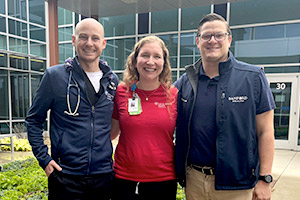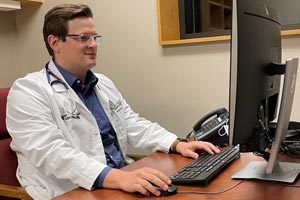Follow the Rural Med Road
By Stacy Kusler on
In the far western North Dakota community of Dickinson, three former medical students from the University of North Dakota (UND) School of Medicine & Health Sciences (SMHS) have found their purpose and passion in rural practice. In their short time in the field, they've learned firsthand the unique challenges of rural healthcare, such as navigating long travel distances for their patients to access specialty care.
But through it all, they're realizing they are right at home in rural.

Samantha (Dusek) Kiedrowski, Nolan Kleinjan, and Mat Gerving are newly minted physicians in Dickinson, all having between one and four years of practice experience. Kiedrowski and Kleinjan work for CHI St. Alexius Health Dickinson, one of North Dakota's 37 Critical Access Hospital (CAHs). Gerving is two miles down the road at Sanford East Dickinson Clinic.
Each physician participated in rural immersion programs during medical school, which paved the way for them to enroll in the RuralMed program, a state-sponsored tuition reimbursement program awarded to SMHS graduates in return for five years of rural practice in North Dakota. The RuralMed program may be what brought the trio to Dickinson, and the ability to make a major impact on rural patients' lives is what keeps them there.
New Faces in the Medical Field
Kleinjan is an internal medicine physician finishing his third year at CHI St. Alexius in Dickinson. When he first started, Kleinjan found it hard to find his place and discover how he could fill the needs of his facility and community.
Starting his practice solely in the clinic, Kleinjan pushed himself to expand his role for the good of his patients. He added hospital and stress test lab work to his schedule. He also started participating in physician committees, like infectious disease prevention and quality committees.
Later, he added the role of director of the cardiac rehab division, as well as interim chief hospitalist, to his list of credentials. Organizations outside of Kleinjan's workplace took notice of his involvement and he now serves on the Western Area Health Education Center (AHEC) board to help steer efforts surrounding clinical rotation support and healthcare leadership development for students.
Looking back now, I believe I am a more complete physician due to pushing those boundaries.
"It was hard to expand my role without feeling that I was stretched too thin, but looking back now, I believe I am a more complete physician due to pushing those boundaries," Kleinjan said.
Kiedrowski started her career at CHI St. Alexius in Dickinson in November 2020, after completing family medicine residency followed by a family medicine obstetrics fellowship at Altru Health System in Grand Forks. Going from trainee to physician proved to be a tough adjustment – at least at first.
"It has been difficult to establish independence in decision making," Kiedrowski said. "I didn't realize I relied so heavily on my 'safety net' of attending physicians and preceptors."
As she nears the end of her fourth year of practice, Kiedrowski has gained confidence as a physician and has quickly become a leader in her facility. She takes part in physician-lead recruitment efforts and serves as a co-director for the Rural Opportunities in Medical Education (ROME) program in her community. Additionally, she is the assistant medical director for Connect Medical Clinic, a clinic that supports sexual health and reproductive healthcare in the Dickinson area.
Gerving is the youngest of the three physicians and is just a year into his practice at Sanford East Dickinson Clinic. According to Gerving, his first year as a rural internal medicine physician has been more daunting than he anticipated.
"Almost every day, I encounter new and complex patients or pathologies that require extensive evaluation for treatment," he said.
Regardless of the challenges, Gerving is confident that he is in the right place for the right reasons.
The most rewarding aspect is when patients express their gratitude even through the most difficult times and look to me for guidance.
"As an internal medicine physician, I can bring the next level of care into a clinical setting and help patients who, due to their illness, feel lost in the medical system," he said. In return, his patients are grateful for the care he can provide. "The most rewarding aspect is when patients express their gratitude even through the most difficult times and look to me for guidance."
Rural Reality
Rural medicine offers a unique opportunity for a simultaneously rewarding and challenging environment. One of the main challenges rural physicians face head-on is the distance required for patients to access specialty care.
Gerving's rural career choice was heavily influenced by his rural upbringing, and by his ROME experience with Dr. Josh Ranum from West River Health Services in Hettinger, North Dakota. While a career in rural health has been in his sights since before medical school, the reality of rural healthcare has been surprising to him.
"My perspective on rural care has changed significantly since starting practice," Gerving said. "In residency, I was in a larger system where specialists and escalation of care was easy to obtain. Now, I must take care of patients who need additional help but either distance, time, or availability get in the way, requiring me to help them how I can locally until that next step can be taken."
Much like Gerving, Kiedrowski's perspective about rural health has flipped since starting practice. What she once thought might be a common day-to-day practice is quite varied and challenging.
Entering residency, I envisioned rural medicine as a sort of 'bread and butter' practice filled with commonly encountered diagnoses. Rural medicine is the exact opposite.
"Entering residency, I envisioned rural medicine as a sort of 'bread and butter' practice filled with commonly encountered diagnoses," she said. "Rural medicine is the exact opposite."
Like Gerving, Kiedrowski noted how referral and travel challenges for her patients complicate her work, adding that these limitations really cause rural physicians to leave no stone unturned when it comes to finding viable solutions for their patients.
"We are asked to stretch our medical brains quite a bit more since we don't have access to specialty referral right at our fingertips," she said. "I've learned to never be surprised in medicine anymore, even here in rural North Dakota, there are rare cases all the time."
Kleinjan says that by choosing to practice in a rural community, he can relieve some of the travel challenges that patients may otherwise face.
"I feel patients are more satisfied with their medical care when they have a local physician treating their medical conditions. I feel this is magnified when working in a rural community," he said. "Patients are grateful they can have excellent medical care and not have to travel to larger referral facilities."
Full Circle Moments
Although each physician is still in the early days of their careers, they've come to realize that rural is where they want to be, and they are wasting no time sharing their passion with the next generation.

Gerving lends his time each year to incoming medical students during Primary Care Week at the UND SMHS in Grand Forks. During the week-long event focused on promoting the different pathways of primary care, Gerving participates in panels to share insights about the impact internal medicine physicians can have in rural communities, as well as tips and advice for what students can do in medical school to prepare for residency.
Kleinjan has made it part of his practice to teach both physician assistant students and medical students, including those in the ROME program. "I believe that it is my responsibility, and joy, to teach medical students due to the excellent experience I had as a ROME student," Kleinjan said.
He wants students to understand the broad scope of practice a rural setting can provide: "I believe rural medicine gives physicians the ability to influence and change a facility at a much greater level [than] at a larger center."
During medical school, Kiedrowski took part in a now-discontinued program called the Don Breen externship through the North Dakota Academy of Family Physicians. Even though she didn't participate in ROME, she serves as the co-director for her ROME site and wants to "pay forward" the excellent experience she had from former teachers.
"I attribute my decision to pursue a career in rural medicine largely to one of my preceptors in my rural rotation," she said. "It's fun for me to pay it forward now as a preceptor myself. The students keep me on my toes. They are always asking great questions that keep my own love of learning alive."


 is the connection between rural healthcare facilities in North Dakota and qualified health professional job seekers. As the workforce specialist, she assists rural facilities to attract medical providers and other health professionals to their communities by sharing job opportunities. Through her position, Stacy is working to reduce the healthcare workforce shortages throughout the state.
is the connection between rural healthcare facilities in North Dakota and qualified health professional job seekers. As the workforce specialist, she assists rural facilities to attract medical providers and other health professionals to their communities by sharing job opportunities. Through her position, Stacy is working to reduce the healthcare workforce shortages throughout the state.



